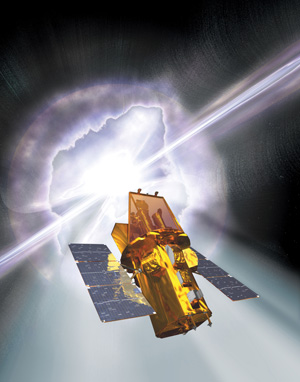|
||
      |
:: By Megan Lisagor
:: Image courtesy Spectrum and NASA E/PO, Sonoma State University, Aurore Simonnet
Citations
Suicide terrorism has secular roots
Contrary to popular belief, religious fundamentalism is rarely suicide
terrorism’s root cause, argues Chicago political scientist Robert
Pape, PhD’88, in his book Dying to Win: The Strategic Logic
of Suicide Terrorism (Random House, 2005). Rather, the terrorists want
to drive out foreign democracies whose military forces occupy their professed
homelands. Pape arrived at this explanation after compiling a database of
every attack worldwide from 1980 to 2003. The majority, he found, had a
secular, strategic goal. To stop rising suicide-terrorism rates, he believes
that the United States and its allies need a new policy that takes the terrorists’
rationale into account.

Satellite and a gamma-ray burst.
Theories out in a flash
The relationship between two types of cosmic blasts is back on the rocks.
Scientists believe X-ray flashes, discovered in 2000, are related to gamma-ray
bursts—the most powerful explosions in the universe—but they
don’t know how. Data from a February 15 flash, captured by NASA’s
Swift and High Energy Transient Explorer-2 satellites, contradict leading
theories explaining the connection, reported Don Lamb,
the Louis Block professor in astronomy & astrophysics and a member of
the HETE-2 science team, at a May meeting of the American Astronomical Society.
Lamb dissects the theories in the working paper “Jet Models of X-ray
Flashes,” written with senior research associate
Carlo Graziani, PhD’93, and graduate student Tim
Donaghy, SM’05. More satellite observations could help solve
the mystery, he suggests, but the space agency plans to deactivate HETE-2
in September.
Not only natural selection
Natural selection has some competition in evolution’s story. The percentage
of mutations that a particular gene accepts also is influenced by how quickly
they arrive there, a team including Bruce Lahn,
assistant professor of genetics, reports in the July Trends in Genetics.
The researchers found that the faster the mutations show up, the more likely
they’ll become fixed in a species. The discovery, based on an analysis
of nearly 6,000 genes, upsets the conventional theory that natural selection
is the sole determinant.
It’s all in the hands
Gesturing has a hand in communication—and not simply as an afterthought,
argues David McNeill, PhD’01, in Gesture
and Thought (University of Chicago Press, 2005). Gestures constitute
the imagery part of an “imagery-language dialectic” that drives
speech and thought, explains McNeill, professor emeritus of linguistics
and psychology. Director of the Center for Gesture and Speech, McNeill showed
a familiar Tweety Bird and Sylvester cartoon to several subjects who spoke
different languages. Those who remembered the exact sequence used the same
motion to describe Sylvester’s location. The gesture, he concluded,
is a foundation of communication.
Give him some credit
Husbands are more useful around the house than their wives think, Linda
Waite, the Lucy Flower professor in urban sociology, and
Yun-Suk Lee, PhD’02, of the University of Seoul, Korea, report
in the May Journal of Marriage and Family. Although wives suspected
their husbands did only 33 percent of the housework, the study tracking
265 married American couples showed the guys actually carried 39 percent
of the weight. It felt like more, however—the husbands claimed they
did 42 percent. Their better halves also overestimated. The wives shouldered
61, not 67, percent of the load. Of course, that’s still nearly double
the men.